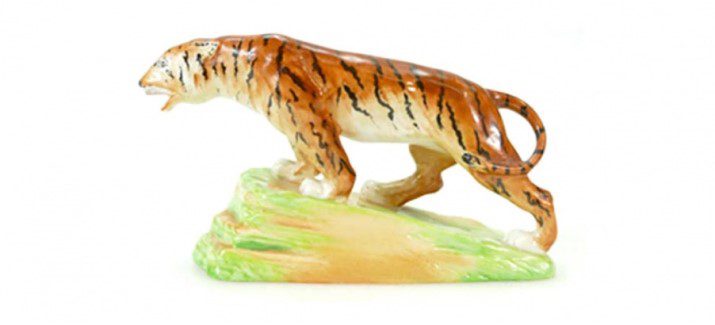
This stunning W H Goss rare model of a tiger on a rock, sold for an incredible £650 in one of our Silverdale Saleroom Fine Art auctions. Proof that WH Goss remains a firm favourite!
Here at Potteries Auctions, we run regular auctions and attract buyers and sellers from all over the world. We’re based in the heart of the Staffordshire Potteries with two salerooms; the Silverdale Saleroom and the Cobridge Saleroom, so we’re best placed to offer valuations and advice. Established in 1991, we are now one of the leading auction houses dealing in 20th century British pottery – including WH Goss.
The History of WH Goss Ceramics and Pottery
WH Goss, or William Henry Goss, was born in London and studied his craft at the School of Design at Somerset House, before moving to become a chief artist for William Taylor Copeland – this was the start of Goss’ journey to the potteries.
In 1858 Goss started his own business in Stoke-on-Trent and started to produce ivory porcelain, Parian, and Earthenware. Goss made his mark with souvenir and commemorative ware, preferring to create ornaments rather than functional items that were popular at time with his contemporaries. It was these souvenir items that helped Goss carve out his career, as collecting become a craze. Seaside resorts across the country have its arms on collectable items made by Goss, each with their very own crest.

While Goss was mostly famously known for glazed porcelain models, the collection of souvenir pieces made by Goss were found up and down the country at seaside resorts and popular towns. Like this Goss Edward VII Royal Commemorative fourteen-piece set that was sold as part of one of our auctions.
How to Identify WH Goss
The Falcon symbol become very synonymous with WH Goss; this was due to the factory name ‘Falcon Works’ where lots of the production took place. You’ll find this rising falcon on most Goss pieces.
On the base of a Goss piece, you might also find an inscription describing the item, along with the Goss name and crest. There are some slight variations of markings, but most unusually, Goss has maintained quite a simple and recognisable marking across the thousands of pieces produced by the ceramist. Whereas other potteries from the same era changed their markings regularly, this helps when identifying pieces and spotting fakes.
WH Goss Backstamps
It’s said that by the of the 19th century WH Goss pieces were so popular that 90% of homes had at least once piece of Goss crested ceramics. So, it could be quite possible to find these pieces in auctions, house clearance, in the back of attics and even some hidden treasures at car boot sales and in charity shops.
Take a note of the backstamps below and check ceramics finds against these stamps to help you identify your WH Goss piece.
It’s worth noting that pieces made after 1931 also have the word England below the mark.

Photo Credit: The Potteries

Goss himself takes centre stage as the model for this magnificent Parian bust, measuring 17cm in height, it’s a great item for any true WH Goss fan. It sold for £65 in our general auction.
How Much are My WH Goss Ceramics Worth?
From the 1960s onward the collectable nature of Gossware increased, and in 1970 the Goss Collectors club was founded and helped to propel the popularity of the work and it remains very collectable.
Potteries Auctions canidentify and provide valuations on a wide range of WH Goss pieces. Please get in touch with usto discuss how we can help you or request a call back if you are looking for an expert evaluation and are seeking to sell your Goss ware pottery.
Did you know we can collect your pottery from anywhere in the UK? We also offer solutions for shipping too. We can pack and safely post your goods, perfect for transporting pieces that have been bought via our online auctions.
